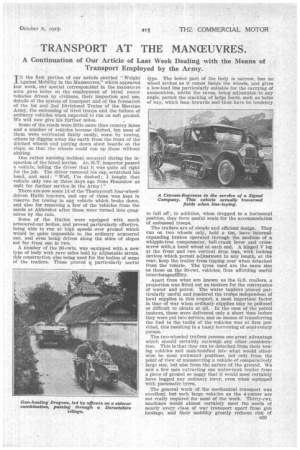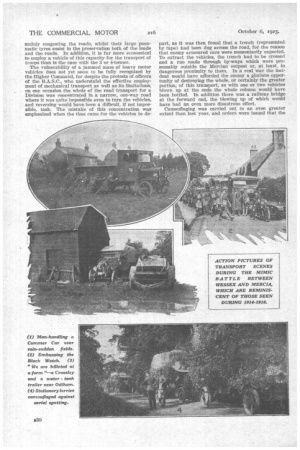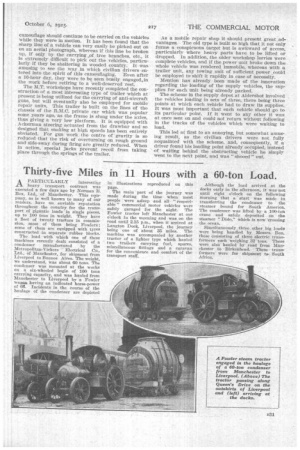TRANSPORT AT THE MANCEUVRES.
Page 13

Page 14

Page 15

If you've noticed an error in this article please click here to report it so we can fix it.
A Continuation of Our Article of Last Week Dealing with the Means of Transport Employed by the Army.
pthe first portion of our article entitled "Weight gainst Mobility in the Manceuvres," which appeared last week, our special correspondent in the manceuvre area gave notes on the employment of hired motor vehicles driven by civilians, their inspection and use, details of the system of transport and of the formation of the 1st and 2nd Divisional Trains of the Mercian Army, the embussing of tired troops and the failure of ordinary vehicles when expected to run on soft ground. We will now give his further notes.
Some of the roads were little more than country lanes and a number of vehicles became ditched, but most of them were extricated fairly easily, some by towing, others by digging away the earth from the front or the ditched wheels and putting down stout boards on the slope, so that the wheels Could run up these without sinking.
One rather amusing incident occurred during the inspection of the hired lorries. An M.T. inspector passed a vehicle, telling the driver that it was quite all right for the job. The driver removed his cap, scratched his head, and said : "Well, I'm dashed; I bought that vehicle only two or three days ago from Hounslow as unfit for further service in the Army ! "
There are now some 14 of the Thornycroft four-wheeldriven Hathi tractors, and one of these was kept in reserve for towing in any vehicle which broke down, and also for removing a few of the vehicles from the sands at Aldershot after these were turned into quagmires by the rain.
Some of the Hathis were equipped with mock armoured-car bodies, and proved particularly effective, being able to run at high speeds over ground which would be quite impossible to the ordinary armoured car, and even being driven along the sides of slopes not far from one in two A number of the 30-cwts. was equipped with a new type of body with rave sides held by adjustable struts, this construction also being used for the bodies of some of the trailers. These proved a. particularly useful. type. The lower part of the body is narrow, has no wheel arches as it comes inside the wheels, and gives a low-load line particularly suitable for the carrying of ammunition, whilst the raves, being adjustable to any angle, permit the stacking of large loads, such as bales of hay, which lean inwards and thus have no tendency to fall off ; in addition, when dropped to a horizontal position, they form useful seats for the accommodation of embussed troops.
The trailers are of simple and efficient design. They run on two wheels only, hold a ton, have internalexpanding brakes operated through the medium of a whipple-tree compensator, bell-crank lever and crossscrew with a hand wheel at each end. A hinged V leg at the front and two vertical drop legs, with locking devices which permit adjustment to any length, at the rear, keep the trailer from tipping over when detached from the vehicle. The tyres used are the same size as those on the 30-cwt. vehicles, thus affording useful interchangeability.
Apart from what are known as the G.S. trailers, a proportion was fitted out as tankers for the conveyance of water and petrol. The water tankers proved particularly useful and rendered the trodps independent of local supplies in this respect, a most important factor, in time of war when ordinary supplies may be polluted or difficult to obtain at all. In the case of the 'petrol tankers, these were delivered only a short time before they were put into service, and no means of transferring the fuel to the tanks of the vehicles was at first provided, this resulting in a hasty borrowing of semi-rotary pumps.
The two-wheeled trailers possess one great advantage
which should certainly outweigh any other consideration. This is that they an be detached from their towing vehicles and man-handled into what would otherwise be most awkward positions, not only from the point of view of manceuvring a vehicle of comparatively large size, but also from the nature of the ground. We saw a few men extracting one water-tank trailer from a piece of ground so soggy that it would most certainly have bogged any ordinary lorry, even when equipped with pneumatic tyres.
The general work of the mechanical transport was
excellent, but such large vehicles as the 4-tonner are not really required for most of the work, Thirty-cwt. machines would almost certainly meet the needs of nearly every class of war transport apart from gun haulage, and their mobility greatly reduces risk of
unduly congesting the roads, whilst their large pneumatic tyres assist in the preservation both of the loads and the roads. In addition, it is far more economical to employ a vehicle of this capacity for the transport of troops than is the case with the 3 or 4-tonner.
The vulnerability of a jammed mass of heavy motor vehicles does not yet seem to be fully recognized by the Higher Command, for despite the protests of officers of the R.A.S.C., who understand the effective employment of mechanical transport as well as its limitations, on one occasion the whole of the road transport for a Division was concentrated in a narrow, one-way road where it was quite impossible even to turn the vehicles, and reversing would have been a difficult, if not impossible, task. The mistake of this concentration was emphasized when the time came for the vehicles to de part, as it was then found that a trench (represented by tape) had been dug across the road, for the reason that enemy armoured cars were momentarily expected. To extract the vehicles, the trench had to be crossed and a run made through by-ways which were presumably outside the Mercian outpost or, at least, in dangerous proximity to them. In a real war the incident would have afforded the enemy a glorious opportunity of destroying the whole, or certainly the greater portion, of this transport, as with one or two vehicles blown up at the ends the whole column would have been bottled. In addition there was a railway bridge at the forward end, the blowing up of which would have had an even more disastrous effect.
Camouflaging was carried out to an even greater extent than last year, and orders were issued that the camouflage should continue to be carried on the vehicles while they were in motion. It has been found that the sharp line of a vehicle can very easily be picked out on on an aerial photograph, whereas if this line be broken up, if only by the carrying ,,of tree branches, etc., i is extremely difficult to pick out the vehicles, partici' larly if they be sheltering in wooded country. It was amusing to see the way in which civilian drivers• en tered into the spirit of this camouflaging. Even after a 16-hour day, they were to be seen busily engaged „in the work before retiring to a well-deserved rest. .
The M.T. workshops have recently completed the con struction of a most interesting type of trailer which at present is being utilized for the carrying of anti-aircraf guns, but will eventually also be employed for mobile repair units. This trailer is built on the fines of the . chassis of the R.M.O. private car which was popular some years ago, -as the frame is slung under the axles thus giviag a very low platform. It is equipped with .Ackerman steering actuated from the drawbar and so designed that snaking at high speeds has been entirely obviated. For gun work the centre of gravity is so reduced that the risk of overturning on rough ground and side-sway during firing are greatly reduced. When in action, special jacks prevent recoil from taking place through the springs of the trailer.
As a mobile repair shop it should present great.advantages. The old type is built so high that it not only forms a conspicuous target but is awkward of access, particularly where heavy parts have to be lifted or dropped. In addition, the older workshop lorries were complete vehicles, and if the power unit broke down the whole vehicle was rendered immobile, whereas with a trailer unit, any towing unit of sufficient power ,could be employed to shift it rapidly in case of necessity.
Mention has already been made of the innovation regarding the loading of the supply vehicles, the supplies for each unit being already packed.
The scheme in the supply depot at Aldershot involved the vehicles loading in sets of three,. there being three points at which each vehicle had to draw its supplies. It was most important that each vehicle should go to its particular point. If it went to any other it was at once sent on and could not return without following in the tracks of the vehicles which were waiting to load.
This led at -first to an annoying, but somewhat amusing result, as the civilian drivers were not fully acquainted with the scheme, and, consequently, if a driver found his loading point already occupied, instead of waiting behind the obstructing vehicle he simply went to the next point, and was " shooed " out.
































